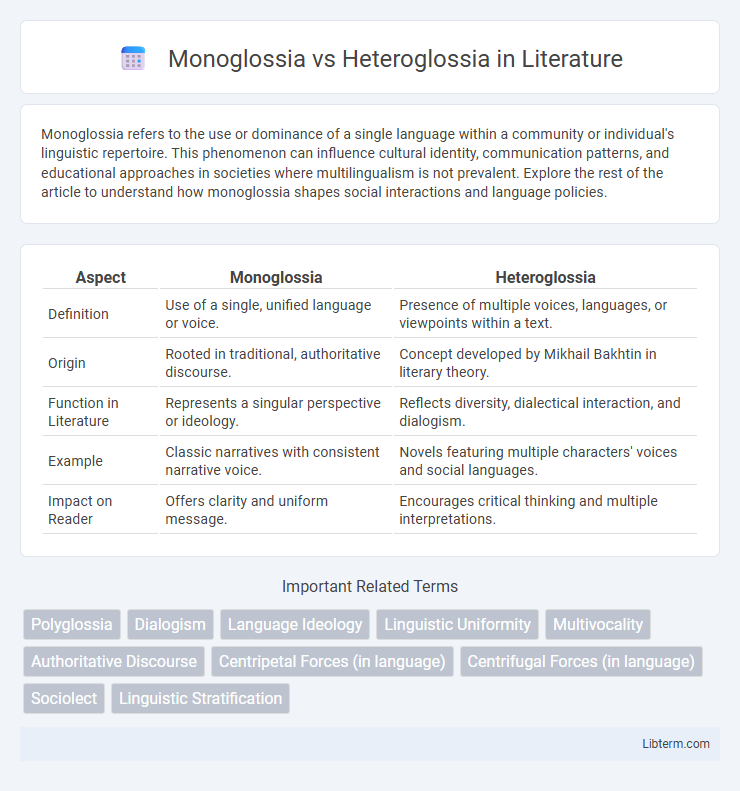Monoglossia refers to the use or dominance of a single language within a community or individual's linguistic repertoire. This phenomenon can influence cultural identity, communication patterns, and educational approaches in societies where multilingualism is not prevalent. Explore the rest of the article to understand how monoglossia shapes social interactions and language policies.
Table of Comparison
| Aspect | Monoglossia | Heteroglossia |
|---|---|---|
| Definition | Use of a single, unified language or voice. | Presence of multiple voices, languages, or viewpoints within a text. |
| Origin | Rooted in traditional, authoritative discourse. | Concept developed by Mikhail Bakhtin in literary theory. |
| Function in Literature | Represents a singular perspective or ideology. | Reflects diversity, dialectical interaction, and dialogism. |
| Example | Classic narratives with consistent narrative voice. | Novels featuring multiple characters' voices and social languages. |
| Impact on Reader | Offers clarity and uniform message. | Encourages critical thinking and multiple interpretations. |
Introduction to Monoglossia and Heteroglossia
Monoglossia refers to a linguistic framework where a single, unified language variety is considered the norm, emphasizing uniformity and standardization within communication. Heteroglossia highlights the coexistence of multiple voices, dialects, and social languages within a single text or social context, reflecting diversity and dialogic interaction. The concept of heteroglossia stems from Mikhail Bakhtin's theory, contrasting with monoglossia's focus on linguistic homogeneity.
Defining Monoglossia: Unity in Language
Monoglossia refers to the perception of language as a unified, homogeneous system where a single, standardized form dominates communication. This concept emphasizes linguistic uniformity, often linked to national language policies and prescriptive grammar norms that prioritize one "correct" way of speaking or writing. In contrast, heteroglossia recognizes the coexistence of multiple dialects, sociolects, and discourses within a language, highlighting diversity and the dynamic nature of linguistic interaction.
Understanding Heteroglossia: Diversity in Discourse
Heteroglossia refers to the coexistence of multiple voices, styles, and perspectives within a single discourse, highlighting the dynamic interplay of social languages and ideological viewpoints. In contrast to monoglossia, which denotes a unified, standardized voice, heteroglossia embraces linguistic diversity and the plurality of meanings shaped by cultural, historical, and social contexts. This concept, central to Bakhtin's theories, underscores how discourse enacts power relations and enriches communication by incorporating varied social experiences and dialogic interactions.
Historical Roots of Monoglossic and Heteroglossic Theories
Monoglossia, rooted in Ferdinand de Saussure's structural linguistics, emphasizes a single, unified language system with fixed meanings and internal coherence. Heteroglossia, introduced by Mikhail Bakhtin, highlights the coexistence of multiple voices, social dialects, and varying perspectives within a language, reflecting its dynamic and dialogic nature. These contrasting theories stem from different historical contexts: Saussure's early 20th-century search for linguistic stability versus Bakhtin's mid-20th-century focus on social diversity and interaction within language.
Monoglossia in Educational Settings
Monoglossia in educational settings emphasizes a single, standardized language policy aimed at uniformity and clarity in communication. This approach often prioritizes the dominant language, potentially marginalizing dialects and minority languages within the classroom environment. Monoglossic frameworks can simplify assessment and curriculum development but may limit linguistic diversity and restrict students' cultural expression.
Heteroglossia and Its Impact on Literary Analysis
Heteroglossia, a concept developed by Mikhail Bakhtin, refers to the coexistence of multiple voices, styles, and perspectives within a single text, contrasting with monoglossia, which presents a singular, unified voice. This linguistic diversity challenges traditional literary analysis by emphasizing the dialogic nature of language and meaning, highlighting how texts interact with social, ideological, and cultural heterogeneity. Understanding heteroglossia enables critics to explore the complexity of narratives, uncover power dynamics, and interpret literature as a site of ongoing negotiation between conflicting discourses.
Social and Cultural Implications of Monoglossia
Monoglossia, characterized by the dominance of a single language within a society, often leads to the marginalization of minority languages and cultures, reinforcing social hierarchies and cultural homogenization. This linguistic uniformity can restrict cultural expression and limit individuals' access to diverse worldviews, impacting social inclusion and identity formation. In contrast, heteroglossia promotes linguistic plurality, fostering multicultural dialogue and enhancing social cohesion through the coexistence of multiple languages and cultural narratives.
The Role of Heteroglossia in Multilingual Societies
Heteroglossia plays a crucial role in multilingual societies by fostering linguistic diversity and promoting intercultural communication through the coexistence of multiple languages and dialects. This dynamic interaction challenges monoglossic norms, enabling speakers to negotiate identities and social meanings across different linguistic contexts. The presence of heteroglossia enhances social cohesion and cultural exchange, making it essential for understanding language use in globalized, multicultural environments.
Monoglossia vs. Heteroglossia: Contemporary Debates
Monoglossia refers to a singular, authoritative language ideology emphasizing uniformity and standardization, while heteroglossia embraces linguistic diversity and the coexistence of multiple voices within a text or society. Contemporary debates focus on how monoglossic perspectives often marginalize minority dialects and restrict creative expression, whereas heteroglossic approaches highlight the dynamic, hybrid nature of communication shaped by cultural and social plurality. Scholars argue that recognizing heteroglossia challenges monolithic language norms and promotes inclusivity in both literary theory and sociolinguistics.
Future Directions in Language Policy and Pluralism
Future directions in language policy emphasize embracing heteroglossia by promoting multilingualism and recognizing diverse linguistic identities within societies. Policies fostering linguistic pluralism encourage educational frameworks that integrate multiple languages, enhancing cognitive flexibility and cultural inclusion. Advances in technology and sociolinguistic research support dynamic language planning models that move beyond monoglossia's singular language focus to address globalization and digital communication challenges.
Monoglossia Infographic

 libterm.com
libterm.com